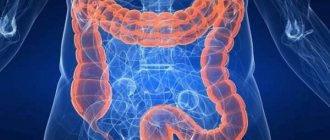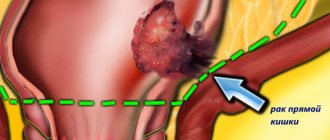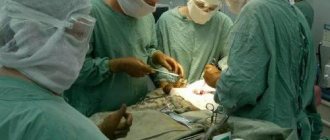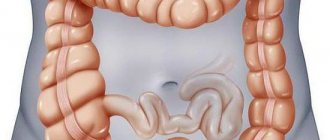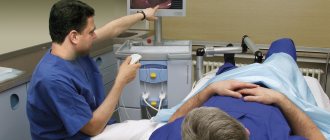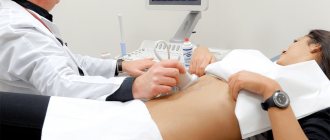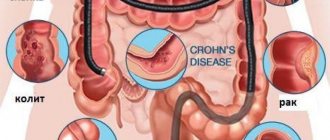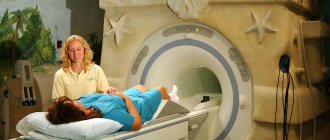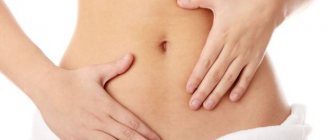Endoscopic examination of the lower digestive tract
Sigmoidoscopy is a type of endoscopic examination that allows you to study in detail the lower (final) part of the digestive tract, as well as take tissue for biopsy, remove a foreign body and other manipulations.
This endoscopy method is performed by introducing a device into the rectal cavity - a sigmoidoscope, with the help of which the image is transmitted to the monitor screen. The procedure is performed on an outpatient basis after preliminary preparation, including bowel cleansing.
Unlike colonoscopy, this examination concerns a small area of the colon (rectum and part of the sigmoid colon - only up to 25 cm), so it does not take much time, is carried out without anesthesia and is easily tolerated by patients.
The essence of the method
The study confirms or excludes the diagnosis of proctological diseases
What is sigmoidoscopy? The method involves diagnosing part of the intestine using a rigid endoscope. It is known that our intestinal tract is located in the abdominal cavity in both straight and curved sections. The endoscope allows the proctologist to examine the rectum and part of the sigmoid colon, that is, examine the intestines to a depth of no more than 35 centimeters from the anus.
Sigmoidoscopy is prescribed by a doctor for the following patient complaints:
- abdominal pain unclear in its etiology (origin);
- constipation and/or diarrhea;
- bloody, mucous or purulent discharge from the anus, including with feces;
- feeling of a full bowel after bowel movement;
- pain in the anus.
Using a proctoscope, a proctologist can check suspicions that a patient has various intestinal diseases, as well as take tissue samples for subsequent biopsy. It is possible to carry out therapeutic manipulations, such as removal of a foreign body, electrocoagulation of intestinal polyps.
Rectoscopy is not performed if the patient is diagnosed with a narrowing of the anus, or because of severe pain (for example, with anal fissures). In the latter case, if the examination is still necessary, the doctor may apply local anesthesia.
Indications
For an accurate diagnosis
The sigmoidoscopy procedure is widely used by doctors for primary diagnosis, that is, to determine the diagnosis of a patient who first contacts a proctologist with specific complaints.
A coloproctologist, gastroenterologist or therapist may recommend undergoing endoscopy of the lower digestive tract if you have the following complaints:
- blood, mucus or pus in the stool;
- pain, sensation of a foreign body in the anus;
- changes in the shape of feces (ribbon-shaped feces);
- persistent constipation followed by diarrhea.
Indications for the procedure of sigmoidoscopy of the intestines may appear during a consultative examination of a patient who has applied for an anal fissure or hemorrhoids. Such a study is necessary to exclude a tumor, inflammatory process, foreign body or other pathology.
For clinical observation and screening examinations
Sigmoidoscopy refers to studies that are not associated with radiation exposure to the body, and therefore can be performed as often as desired. At the same time, endoscopy provides maximum information about pathology when it comes to diseases of the mucous membrane.
Therefore, endoscopic examination of the rectum and sigmoid colon is widely used for preventive purposes - for clinical observation and screening examinations.
Preventive endoscopy of the rectum diagnoses cancer at the earliest stage of development, when the patient does not make any complaints, and the surgeon cannot palpate the tumor during a digital examination.
Dispensary monitoring of already diagnosed diseases using endoscopic methods makes it possible to prevent complications of the disease.
For diagnostic and therapeutic procedures
Another advantage of the sigmoidoscopy procedure is the ability to combine endoscopic examination with diagnostic and therapeutic procedures.
An endoscopic examination can be combined with a biopsy - tissue sampling from a suspicious tumor for cytological examination, which is the main diagnostic procedure when diagnosing a malignant tumor.
During sigmoidoscopy, the doctor can perform a number of microsurgical treatment procedures - cauterize a bleeding vessel, remove a foreign body, remove a polyp (benign neoplasm) of the rectum.
It must be said that the vast majority of polyps are dangerous in relation to malignant degeneration, therefore, after removal, doctors recommend regular preventive examinations (every 3-5 years).
Sigmoidoscope
A cylindrical diagnostic device, which is inserted into the rectum during an endoscopic examination, is called a sigmoidoscope.
The lower part of the digestive tract has no bends. Therefore, for its endoscopic examination, both soft plastic and hard metal sigmoidoscopes are used.
Each sigmoidoscope is equipped with a set of additional devices of a fixed (illuminator) and removable nature. Replacing each other, removable elements allow you to perform additional tasks.
The standard package of the sigmoidoscope includes:
- air supply device;
- optical system, including an eyepiece and a light guide harness;
- forceps;
- biopsy channel;
- obturator
During the examination, the LED fiber of the sigmoidoscope transmits the image to the monitor screen, so that all manipulations are carried out under visual control.
After the study, a record is saved, which is of particular importance for dispensary patients, since it allows you to track the dynamics of the development of the disease.
What the study will show
Endoscopy is an examination of the mucous membrane of the digestive tube. Doctors receive information about the condition of other layers of the intestinal wall indirectly from changes in the pattern of the mucous membrane, abnormal bends, etc.
Sigmoidoscopy of the intestine will provide the maximum amount of information about the following diseases of the lower intestinal tube:
- inflammatory reactions;
- benign neoplasms;
- oncology;
- enlarged hemorrhoids;
- foreign bodies in the intestinal lumen;
- injuries;
- congenital anomalies.
During a sigmoidoscopy examination, the doctor will examine all parts of the rectum (anal canal (4 cm), the following ampullary extension (8-10 cm) and the supramullary part (2-4 cm)), as well as the adjacent part of the sigmoid colon (10-15 cm).
If there is a need to examine the upper parts of the large intestine, then a colonoscopy is prescribed, but if it is advisable to limit the diagnosis to the study of the anal canal, an anoscopy is prescribed.
Contraindications
There are no absolute contraindications to endoscopy. The exception is pathologies that do not technically allow this absolutely safe study to be carried out (mechanical obstruction of the rectum).
Doctors advise postponing the examination if the patient is in serious condition:
- acute infectious diseases;
- exacerbation of chronic diseases of the pelvic organs;
- decompensated cardiovascular, renal or liver failure;
- condition after a heart attack, stroke, etc.
Difficulties with sigmoidoscopy of the intestines can arise in mentally ill people. In such cases, the issue is resolved individually (examination under anesthesia or replacement with another type of diagnosis).
Indications and Contraindications
Indications:
complaints of constipation, diarrhea; discharge from the rectum of mucus, pus, blood; pain in the lower abdomen and rectum; suspicion of the presence of an inflammatory process or neoplasm of the colon; assessment of the results of treatment of certain diseases of the rectum and sigmoid (sigmoid colon, T.) intestines; performing a number of manipulations and operations (taking scrapings and biopsies, removing polyps, foreign bodies, etc.). R., carried out for preventive purposes, is becoming increasingly widespread.
Contraindications:
pronounced acute inflammatory diseases of the rectal wall and surrounding tissues; low-lying stenotic tumors of the rectum, Ch. arr. anal canal; chemical and thermal burns in the acute stage, state of decompensation in cardiovascular pathology, psychosis.
Preparing for the study
Preparation for sigmoidoscopy involves cleansing the intestines of gases and feces. To prevent increased gas formation, three days before the procedure you should avoid peas, pearl barley, cabbage, beans, fresh vegetables and fruits, juices, sparkling water, kvass, alcohol, rye bread and other foods that provoke flatulence.
The day before the procedure, they switch to a slag-free diet (low-fat dietary meat (chicken, turkey), fermented milk products, eggs). Dinner on the eve of the event should be light and early (no later than 12 hours before the examination).
Immediately before the study in the evening and/or morning, the intestines are cleansed with an enema (to clean water) or with a laxative such as Fortrans, which is taken according to the instructions included with the drug.
How to prepare for research
Before sigmoidoscopy, you must adhere to the following rules:
- Preparation begins two days before the examination and consists of diet and bowel cleansing.
Only easily digestible food, mostly liquid, remains in the diet. You can eat omelettes, boiled meat, semolina porridge, broths and jellies. Drink clear juices without pulp, still water. Flour, fruits and vegetables, especially legumes, are prohibited. On the evening before the rectoscopy, it is recommended to limit yourself to weak tea. The actual study is carried out on an empty stomach. - An enema is not given in acute cases of the disease.
Colon cleansing is possible in various ways.
Classic - these are cleansing enemas, which are carried out with water at body temperature (1 liter). One enema is required the evening before the test, two – the next morning. Another way is to take special laxatives, which are designed specifically to cleanse the intestines before proctological examinations. The drug is prescribed by the attending physician. When using laxatives, you must strictly follow the instructions for the drug. - An important point is psychological preparation. For many people, visiting a proctologist is associated with negative emotions, a feeling of embarrassment and shame. It is important to tune in and treat the study like most other medical examinations. You need to realize that non-intervention by a doctor can cause serious problems.
How does the procedure work?
Before an endoscopic examination of the lower intestine, you will need to undress from the waist down and remove your underwear. If the device is equipped with a metal sigmoidoscope, the examination is carried out in the knee-elbow position. When using a soft plastic device, the procedure is performed in a lying position on your side with your knees pulled up to your chest.
Immediately before the procedure, the doctor conducts a digital examination to assess the tone of the sphincter, ensure the patency of the anal canal, and identify swelling, soreness or other pathological symptoms.
After a digital examination, the doctor carefully inserts a sigmoidoscope lubricated with medical petroleum jelly, pumps air, straightening the folds of the mucous membrane, then conducts an examination, and performs diagnostic and therapeutic manipulations according to indications.
The entire procedure takes 10-40 minutes, depending on the structural features of the patient’s intestines, the complexity of diagnosis, and the need for additional manipulations.
How the examination proceeds
If you have complaints about hemorrhoids, you should visit a proctologist. Examination of the intestine using a proctoscope is preceded by a mandatory digital examination of the rectum. It is necessary to assess the condition of the anus and its muscle tone. In addition, there is an area in the rectum that is practically inaccessible for inspection. Only digital examination allows one to determine the presence/absence of pathologies.
Correct posture will reduce discomfort during the examination
Then the actual diagnosis, sigmoidoscopy, is performed. The ideal position of the patient is the knee-elbow position. At the same time, the abdomen sags slightly and relaxes, which allows the doctor to more easily advance the proctoscope. It is also possible to perform sigmoidoscopy on a gynecological chair. The patient's legs should be bent at the knees and pulled towards the stomach. If for some reason a person cannot take the two positions described above, rectoscopy is performed in a lateral position.
The tube is inserted to a depth of 20–35 cm. To straighten the rectum, the doctor pumps up air as necessary.
During the procedure, discomfort is possible, but, according to most patients, this is discomfort and not pain. Here, general muscle relaxation and the absence of tension are very important, which allows sigmoidoscopy to be performed with minimal inconvenience. The whole procedure takes 5 – 10 minutes. If the doctor does not take tissue samples for further research, the results of rectoscopy become known immediately.
Rules of conduct after the examination
Endoscopic examination does not require hospitalization of the patient. After the procedure, the doctor will suggest you rest for a few minutes on the couch, then you can go home.
Since the procedure is accompanied by the injection of gases into the intestines, their free passage is possible throughout the day. This is fine.
When washing the intestines with Fortrans or an enema, beneficial bacteria are “washed out,” and the procedure itself can have an irritating effect on the mucous membrane. Therefore, for 5-7 days after the procedure you need to adhere to a diet (fermented milk products, dietary meat, eggs).
After a week, if there are no other indications, you can abandon the restrictions.
Preparation
Preparation for sigmoidoscopy is not difficult; it is possible to prepare at home. Current nuances include following a diet and cleansing the body with an enema. A special diet is introduced two days in advance, and the food is prescribed by a specialist. The diet includes bran, herbal and dietary teas, lean meat, and fish. Avoid foods that cause gas, legumes, fruits, and alcohol. You can eat semolina porridge. Fermented milk drinks are being added to the menu. It is recommended to drink water. The day before sigmoidoscopy, cleaning is carried out with enemas and laxatives.
Patient reviews about the procedure
We analyzed reviews of intestinal sigmoidoscopy. It can be concluded that the vast majority of patients who underwent the procedure characterize the study as unpleasant, but painless.
Many reviews record the impression that waiting for the procedure brings more unpleasant worries than the examination itself. In some patients, the bowel cleansing procedure caused discomfort. To avoid such sensations, it is better to use laxatives like Fortrans instead of microenemas, which can cause irritation of the mucous membrane.
There are relatively few complaints of pain during sigmoidoscopy examination of the intestine. Patients complain of pain and discomfort during the entry of air into the intestine, as well as during the examination procedure.
Features of the use of drugs to prepare for examination
Fortrans
The drug is safe and allows you to gently cleanse the intestines. At the same time, it does not affect the microflora and biological processes in the body, therefore it has no contraindications or side effects. Its mechanism of action is to slow down the absorption of fluid in the intestines, as a result of which it accumulates in the intestines and dilutes the stool. The drug is excreted in the stool. Unlike similar products, Fortrans does not cause pain or discomfort after administration or during bowel movements.
Fleet phospho-soda
This drug, like Fortrans, does not enter the bloodstream and retains fluid in the intestines, which helps soften the stool. But it has some contraindications:
- renal dysfunction;
- heart failure;
- intestinal obstruction;
- cannot be taken on a salt-free diet.
Microlax
Microlax cleanses the distal intestine. The product is available in the form of disposable syringes that contain a laxative solution. Cleansing can be carried out both in the evening before the examination and in the morning. For this, 2–3 microenemas are enough. The interval between them is 15 minutes. Thanks to the body’s quick reaction (the urge to defecate will begin within 10–20 minutes), this drug can be used immediately before manipulation, which significantly reduces the time for preparation and does not impair its quality at all.
Duphalac
Gently cleanses the intestines, softening its contents and at the same time causing contraction of the walls, which promotes the rapid removal of feces from the body. The drug is allowed to be taken by patients of any age. Directions for use: dilute 200 ml of suspension in two liters of water and drink in small sips over 2 – 3 hours.
Lavacol
The effect of the drug is similar to Fortrans and Flit phospho-soda. Contraindications for use are also the same. The package contains 15 sachets, which you need to drink, diluting each in a glass of water. The drug has an unpleasant salty taste, but it can be improved by adding syrup or jam to the water. While taking Lavacol, you should drink plenty of fluids. It can be weak tea, broth or juice. When cleansing the intestines with laxatives, it is necessary not only to drink a lot of liquid, but also to walk more and constantly massage the stomach.
